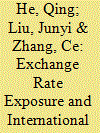| Srl | Item |
| 1 |
ID:
180468


|
|
|
|
|
| Summary/Abstract |
This study analyzes how exchange rate risk exposure and foreign industry competition affect Chinese industries. Using the data from 2005 to 2018, the authors find that industry competition from the US has a statistically significant influence on 33.3 percent of Chinese industries. Unsurprisingly, tradable goods benefit more from depreciation of the Renminbi against the US dollar. Counterintuitively, only 20 percent of the industries supported by the ‘Made in China 2025’ initiative is sensitive to US industrial competition. In addition, on average Chinese industries face international competition from few developed countries, such as the Netherlands; and depreciation of RMB against the Japanese yen is hurting Chinese industries on average. Developing countries, however, exert marginal competition effects on their Chinese counterparts in the sample period.
|
|
|
|
|
|
|
|
|
|
|
|
|
|
|
|
| 2 |
ID:
182722


|
|
|
|
|
| Summary/Abstract |
This paper investigates the foreign exchange rate exposure and its determinants using the data of all firms listed on the Chinese stock market from 2005 to 2018. We find significantly linear and nonlinear exposures to bilateral as well as multilateral foreign exchange rates. Our temporal study also shows that considerably more Chinese firms were exposed to exchange rate fluctuations after the major exchange rate reform in 2015. We find a negligible role played by international operations of firms in explaining exposures. The level of exchange rate exposure is primarily explained by variables that are proxies for a firm's hedging costs. Larger firms, or firms with less leverage ratio, tend to have smaller exposures. Exposure is found to increase with a firm's growth opportunity. Last but not least, we find that leverage ratios and growth opportunities impact more significantly on exposures for firms with separation of control and cash flow rights.
|
|
|
|
|
|
|
|
|
|
|
|
|
|
|
|